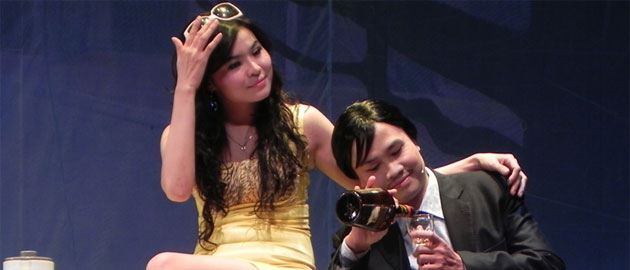Another “cai luong” (traditional southern music and stage performance) play which fuses movie effects is set to be staged in Hanoi on September 18.
The play, titled “Khi hoa no trai mua” (When the flowers are in unseasonable bloom), will take place at Hong Ha Theater, 51 Duong Thanh street, Hoan Kiem district, at 8pm tonight.
With the incorporation of cinematic elements including scenes shot outside the stage and sounds, the Hanoi Cai luong Theater, the play’s producer, hopes to enhance the play’s overall effectiveness and smooth the intervals in which scenes and props are changed.
This is the second play of the theater’s project to fuse the traditional genre with motion pictures, which was recently kicked off in an attempt to rejuvenate “cai luong” and revive audiences’ waning interest in the genre.
However, its first show wasn’t quite a success. The show titled “Yeu la thoat toi” (To love is to be cleared of sin), which was recently staged at Hong Ha Theater, depicted the familiar historical story of illustrious scholar, poet and politician Nguyen Trai (1380–1442) in one of the country’s most famous historical stories, in which Trai was calumniated, resulting in the execution of himself, his family, distant relatives and in-laws.
The show is different from conventional “cai luong” performances in that it had stage scenes intertwined with video clips which featured the actors and actresses and were intended to fill the intervals during which props were changed for new scenes, and illuminate several of the play’s intricate details.
The clips were painstakingly made and cost much more than a conventional performance, with the “cai luong” artists practicing hard for a month and traveling long distances to shoot them. However, they didn’t achieve the desired effect. The clips, shown on the big screen, made the audiences continually look up at the screen above to follow the play. That disrupted the emotions which the otherwise seamless flow of the “cai luong” play was arousing among the audience.
In addition, the clips, designed to further illustrate the play’s intricate details and knots, seemed redundant and could entirely be done without.
Along with the clips, sound effects, such as the pouring of wine into a glass or the pounding of horse hooves on the ground, which are borrowed from motion pictures, were also employed. However, the dubbed sounds didn’t match well with the actions performed onstage.
This fusion isn’t pioneering, however. In the 1990s, the Vietnam Cai luong Theater incorporated motion picture effects into their “cai luong” play titled “Khi thanh pho len den” (The city at night). The blend wasn’t very conspicuous and it was quite a success.
The theater, however, later dropped the model and returned to the conventional form due to the exorbitant costs.
Elements from motion pictures have also been found in other stage performance genres, including drama. Several major plays, as well as graduation plays at art schools, have employed film effects to certain success.


















































